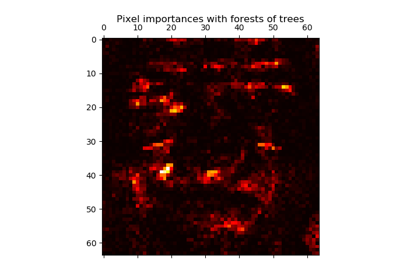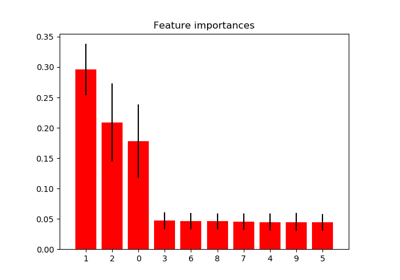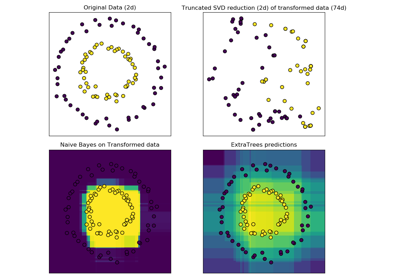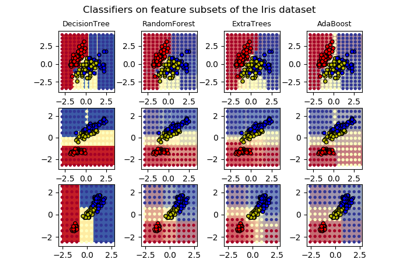3.2.4.3.3. sklearn.ensemble.ExtraTreesClassifier¶
-
class
sklearn.ensemble.ExtraTreesClassifier(n_estimators=100, criterion='gini', max_depth=None, min_samples_split=2, min_samples_leaf=1, min_weight_fraction_leaf=0.0, max_features='auto', max_leaf_nodes=None, min_impurity_decrease=0.0, min_impurity_split=None, bootstrap=False, oob_score=False, n_jobs=None, random_state=None, verbose=0, warm_start=False, class_weight=None, ccp_alpha=0.0, max_samples=None)[source]¶ An extra-trees classifier.
This class implements a meta estimator that fits a number of randomized decision trees (a.k.a. extra-trees) on various sub-samples of the dataset and uses averaging to improve the predictive accuracy and control over-fitting.
Read more in the User Guide.
- Parameters
- n_estimatorsinteger, optional (default=10)
The number of trees in the forest.
Changed in version 0.22: The default value of
n_estimatorschanged from 10 to 100 in 0.22.- criterionstring, optional (default=”gini”)
The function to measure the quality of a split. Supported criteria are “gini” for the Gini impurity and “entropy” for the information gain.
- max_depthinteger or None, optional (default=None)
The maximum depth of the tree. If None, then nodes are expanded until all leaves are pure or until all leaves contain less than min_samples_split samples.
- min_samples_splitint, float, optional (default=2)
The minimum number of samples required to split an internal node:
If int, then consider
min_samples_splitas the minimum number.If float, then
min_samples_splitis a fraction andceil(min_samples_split * n_samples)are the minimum number of samples for each split.
Changed in version 0.18: Added float values for fractions.
- min_samples_leafint, float, optional (default=1)
The minimum number of samples required to be at a leaf node. A split point at any depth will only be considered if it leaves at least
min_samples_leaftraining samples in each of the left and right branches. This may have the effect of smoothing the model, especially in regression.If int, then consider
min_samples_leafas the minimum number.If float, then
min_samples_leafis a fraction andceil(min_samples_leaf * n_samples)are the minimum number of samples for each node.
Changed in version 0.18: Added float values for fractions.
- min_weight_fraction_leaffloat, optional (default=0.)
The minimum weighted fraction of the sum total of weights (of all the input samples) required to be at a leaf node. Samples have equal weight when sample_weight is not provided.
- max_featuresint, float, string or None, optional (default=”auto”)
The number of features to consider when looking for the best split:
If int, then consider
max_featuresfeatures at each split.If float, then
max_featuresis a fraction andint(max_features * n_features)features are considered at each split.If “auto”, then
max_features=sqrt(n_features).If “sqrt”, then
max_features=sqrt(n_features).If “log2”, then
max_features=log2(n_features).If None, then
max_features=n_features.
Note: the search for a split does not stop until at least one valid partition of the node samples is found, even if it requires to effectively inspect more than
max_featuresfeatures.- max_leaf_nodesint or None, optional (default=None)
Grow trees with
max_leaf_nodesin best-first fashion. Best nodes are defined as relative reduction in impurity. If None then unlimited number of leaf nodes.- min_impurity_decreasefloat, optional (default=0.)
A node will be split if this split induces a decrease of the impurity greater than or equal to this value.
The weighted impurity decrease equation is the following:
N_t / N * (impurity - N_t_R / N_t * right_impurity - N_t_L / N_t * left_impurity)
where
Nis the total number of samples,N_tis the number of samples at the current node,N_t_Lis the number of samples in the left child, andN_t_Ris the number of samples in the right child.N,N_t,N_t_RandN_t_Lall refer to the weighted sum, ifsample_weightis passed.New in version 0.19.
- min_impurity_splitfloat, (default=1e-7)
Threshold for early stopping in tree growth. A node will split if its impurity is above the threshold, otherwise it is a leaf.
Deprecated since version 0.19:
min_impurity_splithas been deprecated in favor ofmin_impurity_decreasein 0.19. The default value ofmin_impurity_splitwill change from 1e-7 to 0 in 0.23 and it will be removed in 0.25. Usemin_impurity_decreaseinstead.- bootstrapboolean, optional (default=False)
Whether bootstrap samples are used when building trees. If False, the whole dataset is used to build each tree.
- oob_scorebool, optional (default=False)
Whether to use out-of-bag samples to estimate the generalization accuracy.
- n_jobsint or None, optional (default=None)
The number of jobs to run in parallel.
fit,predict,decision_pathandapplyare all parallelized over the trees.Nonemeans 1 unless in ajoblib.parallel_backendcontext.-1means using all processors. See Glossary for more details.- random_stateint, RandomState instance or None, optional (default=None)
Controls 3 sources of randomness:
the bootstrapping of the samples used when building trees (if
bootstrap=True)the sampling of the features to consider when looking for the best split at each node (if
max_features < n_features)the draw of the splits for each of the
max_features
See Glossary for details.
- verboseint, optional (default=0)
Controls the verbosity when fitting and predicting.
- warm_startbool, optional (default=False)
When set to
True, reuse the solution of the previous call to fit and add more estimators to the ensemble, otherwise, just fit a whole new forest. See the Glossary.- class_weightdict, list of dicts, “balanced”, “balanced_subsample” or None, optional (default=None)
Weights associated with classes in the form
{class_label: weight}. If not given, all classes are supposed to have weight one. For multi-output problems, a list of dicts can be provided in the same order as the columns of y.Note that for multioutput (including multilabel) weights should be defined for each class of every column in its own dict. For example, for four-class multilabel classification weights should be [{0: 1, 1: 1}, {0: 1, 1: 5}, {0: 1, 1: 1}, {0: 1, 1: 1}] instead of [{1:1}, {2:5}, {3:1}, {4:1}].
The “balanced” mode uses the values of y to automatically adjust weights inversely proportional to class frequencies in the input data as
n_samples / (n_classes * np.bincount(y))The “balanced_subsample” mode is the same as “balanced” except that weights are computed based on the bootstrap sample for every tree grown.
For multi-output, the weights of each column of y will be multiplied.
Note that these weights will be multiplied with sample_weight (passed through the fit method) if sample_weight is specified.
- ccp_alphanon-negative float, optional (default=0.0)
Complexity parameter used for Minimal Cost-Complexity Pruning. The subtree with the largest cost complexity that is smaller than
ccp_alphawill be chosen. By default, no pruning is performed. See Minimal Cost-Complexity Pruning for details.New in version 0.22.
- max_samplesint or float, default=None
If bootstrap is True, the number of samples to draw from X to train each base estimator.
If None (default), then draw
X.shape[0]samples.If int, then draw
max_samplessamples.If float, then draw
max_samples * X.shape[0]samples. Thus,max_samplesshould be in the interval(0, 1).
New in version 0.22.
- Attributes
- base_estimator_ExtraTreeClassifier
The child estimator template used to create the collection of fitted sub-estimators.
- estimators_list of DecisionTreeClassifier
The collection of fitted sub-estimators.
- classes_array of shape (n_classes,) or a list of such arrays
The classes labels (single output problem), or a list of arrays of class labels (multi-output problem).
- n_classes_int or list
The number of classes (single output problem), or a list containing the number of classes for each output (multi-output problem).
feature_importances_ndarray of shape (n_features,)Return the feature importances (the higher, the more important the feature).
- n_features_int
The number of features when
fitis performed.- n_outputs_int
The number of outputs when
fitis performed.- oob_score_float
Score of the training dataset obtained using an out-of-bag estimate. This attribute exists only when
oob_scoreis True.- oob_decision_function_array of shape (n_samples, n_classes)
Decision function computed with out-of-bag estimate on the training set. If n_estimators is small it might be possible that a data point was never left out during the bootstrap. In this case,
oob_decision_function_might contain NaN. This attribute exists only whenoob_scoreis True.
See also
sklearn.tree.ExtraTreeClassifierBase classifier for this ensemble.
RandomForestClassifierEnsemble Classifier based on trees with optimal splits.
Notes
The default values for the parameters controlling the size of the trees (e.g.
max_depth,min_samples_leaf, etc.) lead to fully grown and unpruned trees which can potentially be very large on some data sets. To reduce memory consumption, the complexity and size of the trees should be controlled by setting those parameter values.References
- Rc8f28bfad63f-1
P. Geurts, D. Ernst., and L. Wehenkel, “Extremely randomized trees”, Machine Learning, 63(1), 3-42, 2006.
Examples
>>> from sklearn.ensemble import ExtraTreesClassifier >>> from sklearn.datasets import make_classification >>> X, y = make_classification(n_features=4, random_state=0) >>> clf = ExtraTreesClassifier(n_estimators=100, random_state=0) >>> clf.fit(X, y) ExtraTreesClassifier(random_state=0) >>> clf.predict([[0, 0, 0, 0]]) array([1])
Methods
apply(self, X)Apply trees in the forest to X, return leaf indices.
decision_path(self, X)Return the decision path in the forest.
fit(self, X, y[, sample_weight])Build a forest of trees from the training set (X, y).
get_params(self[, deep])Get parameters for this estimator.
predict(self, X)Predict class for X.
predict_log_proba(self, X)Predict class log-probabilities for X.
predict_proba(self, X)Predict class probabilities for X.
score(self, X, y[, sample_weight])Return the mean accuracy on the given test data and labels.
set_params(self, \*\*params)Set the parameters of this estimator.
-
__init__(self, n_estimators=100, criterion='gini', max_depth=None, min_samples_split=2, min_samples_leaf=1, min_weight_fraction_leaf=0.0, max_features='auto', max_leaf_nodes=None, min_impurity_decrease=0.0, min_impurity_split=None, bootstrap=False, oob_score=False, n_jobs=None, random_state=None, verbose=0, warm_start=False, class_weight=None, ccp_alpha=0.0, max_samples=None)[source]¶ Initialize self. See help(type(self)) for accurate signature.
-
apply(self, X)[source]¶ Apply trees in the forest to X, return leaf indices.
- Parameters
- X{array-like or sparse matrix} of shape (n_samples, n_features)
The input samples. Internally, its dtype will be converted to
dtype=np.float32. If a sparse matrix is provided, it will be converted into a sparsecsr_matrix.
- Returns
- X_leavesarray_like, shape = [n_samples, n_estimators]
For each datapoint x in X and for each tree in the forest, return the index of the leaf x ends up in.
-
decision_path(self, X)[source]¶ Return the decision path in the forest.
New in version 0.18.
- Parameters
- X{array-like or sparse matrix} of shape (n_samples, n_features)
The input samples. Internally, its dtype will be converted to
dtype=np.float32. If a sparse matrix is provided, it will be converted into a sparsecsr_matrix.
- Returns
- indicatorsparse csr array, shape = [n_samples, n_nodes]
Return a node indicator matrix where non zero elements indicates that the samples goes through the nodes.
- n_nodes_ptrarray of size (n_estimators + 1, )
The columns from indicator[n_nodes_ptr[i]:n_nodes_ptr[i+1]] gives the indicator value for the i-th estimator.
-
property
feature_importances_¶ - Return the feature importances (the higher, the more important the
feature).
- Returns
- feature_importances_array, shape = [n_features]
The values of this array sum to 1, unless all trees are single node trees consisting of only the root node, in which case it will be an array of zeros.
-
fit(self, X, y, sample_weight=None)[source]¶ Build a forest of trees from the training set (X, y).
- Parameters
- Xarray-like or sparse matrix of shape (n_samples, n_features)
The training input samples. Internally, its dtype will be converted to
dtype=np.float32. If a sparse matrix is provided, it will be converted into a sparsecsc_matrix.- yarray-like of shape (n_samples,) or (n_samples, n_outputs)
The target values (class labels in classification, real numbers in regression).
- sample_weightarray-like of shape (n_samples,), default=None
Sample weights. If None, then samples are equally weighted. Splits that would create child nodes with net zero or negative weight are ignored while searching for a split in each node. In the case of classification, splits are also ignored if they would result in any single class carrying a negative weight in either child node.
- Returns
- selfobject
-
get_params(self, deep=True)[source]¶ Get parameters for this estimator.
- Parameters
- deepbool, default=True
If True, will return the parameters for this estimator and contained subobjects that are estimators.
- Returns
- paramsmapping of string to any
Parameter names mapped to their values.
-
predict(self, X)[source]¶ Predict class for X.
The predicted class of an input sample is a vote by the trees in the forest, weighted by their probability estimates. That is, the predicted class is the one with highest mean probability estimate across the trees.
- Parameters
- Xarray-like or sparse matrix of shape (n_samples, n_features)
The input samples. Internally, its dtype will be converted to
dtype=np.float32. If a sparse matrix is provided, it will be converted into a sparsecsr_matrix.
- Returns
- yarray-like of shape (n_samples,) or (n_samples, n_outputs)
The predicted classes.
-
predict_log_proba(self, X)[source]¶ Predict class log-probabilities for X.
The predicted class log-probabilities of an input sample is computed as the log of the mean predicted class probabilities of the trees in the forest.
- Parameters
- Xarray-like or sparse matrix of shape (n_samples, n_features)
The input samples. Internally, its dtype will be converted to
dtype=np.float32. If a sparse matrix is provided, it will be converted into a sparsecsr_matrix.
- Returns
- parray of shape (n_samples, n_classes), or a list of n_outputs
such arrays if n_outputs > 1. The class probabilities of the input samples. The order of the classes corresponds to that in the attribute classes_.
-
predict_proba(self, X)[source]¶ Predict class probabilities for X.
The predicted class probabilities of an input sample are computed as the mean predicted class probabilities of the trees in the forest. The class probability of a single tree is the fraction of samples of the same class in a leaf.
- Parameters
- Xarray-like or sparse matrix of shape (n_samples, n_features)
The input samples. Internally, its dtype will be converted to
dtype=np.float32. If a sparse matrix is provided, it will be converted into a sparsecsr_matrix.
- Returns
- parray of shape (n_samples, n_classes), or a list of n_outputs
such arrays if n_outputs > 1. The class probabilities of the input samples. The order of the classes corresponds to that in the attribute classes_.
-
score(self, X, y, sample_weight=None)[source]¶ Return the mean accuracy on the given test data and labels.
In multi-label classification, this is the subset accuracy which is a harsh metric since you require for each sample that each label set be correctly predicted.
- Parameters
- Xarray-like of shape (n_samples, n_features)
Test samples.
- yarray-like of shape (n_samples,) or (n_samples, n_outputs)
True labels for X.
- sample_weightarray-like of shape (n_samples,), default=None
Sample weights.
- Returns
- scorefloat
Mean accuracy of self.predict(X) wrt. y.
-
set_params(self, **params)[source]¶ Set the parameters of this estimator.
The method works on simple estimators as well as on nested objects (such as pipelines). The latter have parameters of the form
<component>__<parameter>so that it’s possible to update each component of a nested object.- Parameters
- **paramsdict
Estimator parameters.
- Returns
- selfobject
Estimator instance.




